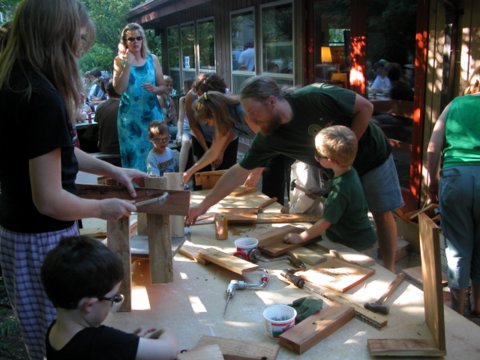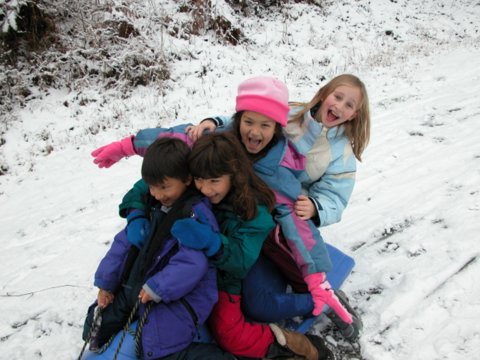


Kids at Sharingwood

|

|

|
Kids at Sharingwood live in an environment that offers many qualities rarely found in modern society. Since Sharingwood is at the end of a dead-end private road, and is surrounded by the greenbelt on the three other sides, it provides a fairly isolated setting.
There are many child-friendly areas within Sharingwood. Outside the common house is a playground with swings, a sandbox, and climbing structures. This is regularly used by children through the day and especially at meal-times, as it is within sight of the common house where events are often held.
Near the common house is an island full of trees and bushes that is known as "Pirate Island". This is often used as a hiding place and walking area for young children while others play on the playground. Pirate Island has a tire swing, trails, and a good climbing tree.
Phase II (the Garden Loop) has what's called the "Big Island", which is a large piece of common land surrounded by the Garden Loop pedestrian road. The Big Island hosts the playfield, a climbing dome and another playground, community gardens, fruit trees and greenhouse, a tree-lined trail, fire-circle, large sand-box as well as two private homes.
The Playfield on the Big Island is a large grassy area, with a Geodesic dome and some rock structures. There are often games organized around the playfield, such as soccer, softball, kickball and capture the flag, as well as larger events on occasion
In summer, Sharingwood is flush with fruits and berries and you will often find children snacking along the path.
Older children sometimes congregate in the camp area of the greenbelt. This is near a stream and is about 100 feet into the greenbelt, providing some privacy from the general community.
In the last couple years, walkie-talkies have become commonplace and a way for parents to keep close contact with their children. Parents who have raised children in Sharingwood often feel that it provides a nice setting to encourage some degree of independence, while remaining in a safe environment.
Benefits of Cohousing for Parents and Children
Stories from around the Country
I was hunkered down underneath my car doing something oily and I could see down the street as one of my neighbors, Michelle, was trying to set out some metal light fixtures to spray paint. Every time she lined them up, her toddler would carry one off or otherwise disrupt the process.
I was tied up working on the car so I couldn't help her, but I didn't need to. Rosemary, another neighbor, walked up to the toddler with a couple of little baskets, took her hand and diverted her into picking berries, while the mom gratefully arranged the lights and painted them without interruption.
The thing that I did not realize until later reflection is that Michelle never had to ask for help. Her neighbors saw her needs, and helped her in the quiet, unspoken way that communities work.
One day our neighbors were in a dither because the in-laws were coming to visit for the first time, and the house was a mess and they had very little time to work on it. I took their two boys off on a long expedition in the greenbelt to look for frogs, bugs, birds and the like. I kept an ear cocked for the arrival of the in-laws, and delivered the boys right as Grandpa and Grandma arrived. The house was spotless, and I never mentioned the field trip. However, after the in-laws left, I came home to find a six-pack of very good beer on my front step with a simple card that just said, Community works!
I noticed one summer evening my daughter had a new bandage on her elbow. She had been playing on the other side of the community and had fallen down. A neighbor heard her crying, comforted her, brought her in and cleaned her up, bandaged the small scrape, fed her some cookies and juice and sent her off, good as new. I never even knew about it until I saw the bandage; my neighbor did exactly what I would have done.
On another day one of the older girls was walking down the road with an adult I did not recognize. She was clearly showing the place off and I thought maybe a tourist (we get a lot of those) had asked her for a tour. It turns out he was her teacher from school. He was so impressed with her conflict skills, group skills, and maturity in working with adults that he had come to see where she lived. He later joined another cohousing group.
From Rob Sandelin, Sharingwood, Snohomish, WA
I moved here with high expectations, and they have been met. It's amazing to come home from work, hang out with the kids and the spouse (and the neighbors) for awhile, then sit down to a great meal, with no prep work and no clean-up. And this is the norm (15-18 days a month), not the exception.
The friendships among the children are wonderful to see. Barely a day goes by when the neighbor kids don't show up at our house before it's even time to go to school. The boys here, ages 4-12, are more like brothers than traditional friends. (I can speak for the boys because two of them are mine; it appears to be the same with the girls.) My older son (age 7) prefers to be home, at Muir Commons, to anything else, including vacation, unless it's a Muir Commons group vacation, and his friends are there too.
Common meals ... happy hours ... birthday parties ... game nights ... movie nights ... "Women's Night Out" ... "Men's Weekend Out" ... song circles ... planning & planting our gardens together ... dancing at dawn in celebration of the equinox ... friendships with a lot of wonderful people ... it really is "the good life."
From Lori Llewelyn, Muir Commons, Davis CA
In our community, one of the benefits is that single kids grow up with an extended family of instant brothers and sisters of various ages. Children have older sisters and brothers to adore (because there is no sibling rivalry). These other children can, depending upon their ages, act as siblings or sitters.
Also, as children grow into their teens and tend to become less communicative with their parents, there are other adults with whom they have become friends during their earlier years ... Not only is it great for the kids, but the parents get a break as they swap children and have time for themselves in adult activities
.From David Dobkin, Berkeley Cohousing, Berkeley, CA

